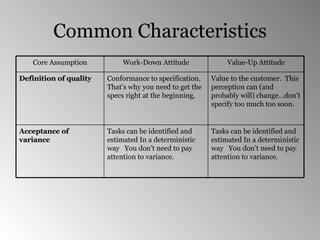The Value-Up Paradigm
- 1. The Value-Up Paradigm Software Engineering with Microsoft Visual Studio Team System
- 2. Agile Declaration of Independence We increase return on investment by making continuous flow of value our focus. We deliver reliable results by engaging customers in frequent interactions and shared ownership. We expect uncertainty and manage for it through iterations, anticipation, and adaptation. We unleash creativity and innovation by recognizing that individuals are the ultimate source of value, and creating an environment where they can make a difference. We boost performance through group accountability for results and shared responsibility for team effectiveness. We improve effectiveness and reliability through situationally specific strategies, processes and practices.
- 3. Contrasting Paradigms The Work-Down Approach The team’s focus is to make way through a list of planned tasks. The Value-Up Approach The team’s focus is on a consistent flow of customer value as the driver of the project.
- 4. Value-Up Focus on Flow You do not measure planned tasks completed as the primary indicator of progress; you count units of value delivered.
- 5. Requirements MSF recommends gathering requirements one iteration at a time. The iteration then becomes a batch of requirements that progress through realization. This methodology: Maximizes communication Keeps requirements fresh Avoids wasted work Keeps the focus on the delivery of customer value
- 6. Common Characteristics Core Assumption Work-Down Attitude Value-Up Attitude Planning and change process Planning and design are the most important activities to get right. You need to do these initially, establish accountability to plan, and monitor against the plan, and carefully prevent change from creeping in. Change happens, embrace it. Planning and design will continue through the project. Therefore you should invest in just enough planning and design to understand risk and to manage the next small increment. Primary measurement Task completion. Because we know the steps to achieve the end goal. Only deliverables that the customer values (working software, completed documentation, etc.) count.
- 7. Common Characteristics Core Assumption Work-Down Attitude Value-Up Attitude Definition of quality Conformance to specification. That’s why you need to get the specs right at the beginning. Value to the customer. This perception can (and probably will) change…don’t specify too much too soon. Acceptance of variance Tasks can be identified and estimated In a deterministic way You don’t need to pay attention to variance. Tasks can be identified and estimated In a deterministic way You don’t need to pay attention to variance.
- 8. Common Characteristics Core Assumption Work-Down Attitude Value-Up Attitude Troubleshooting approach The constraints of time, resource, functionality and quality determine what you can achieve. If you adjust one, you need to adjust the others. The constraints may or may not be related to time, resource, functionality, or quality. Keep reducing variance to ensure smoother flow. Approach to Trust People need to be monitored and measured to standards. Incentives should be used by management to reward individuals for their performance relative to plan. Pride of workmanship and teamwork are more effective than individual incentives. Trustworthy transparency, where the whole team can see all the team’s performance data, works better than management directive.








